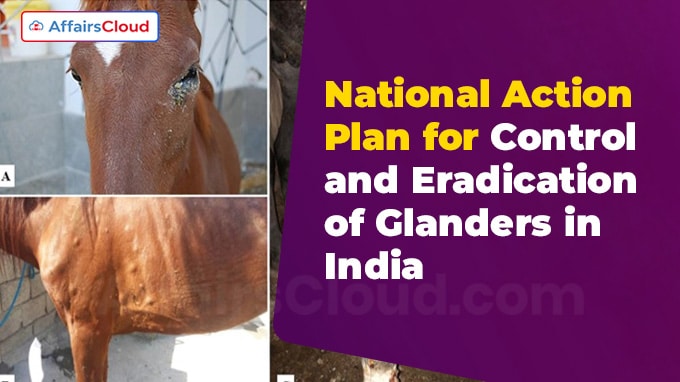 On August 27, 2025, the Department of Animal Husbandry & Dairying (DAHD), Ministry of Fisheries, Animal Husbandry & Dairying (MoFAH&D) has issued the ‘Revised National Action Plan on Glanders(a contagious and often fatal disease of equines)’, with an aim to strengthen surveillance, prevention, control and eradication of the disease.
On August 27, 2025, the Department of Animal Husbandry & Dairying (DAHD), Ministry of Fisheries, Animal Husbandry & Dairying (MoFAH&D) has issued the ‘Revised National Action Plan on Glanders(a contagious and often fatal disease of equines)’, with an aim to strengthen surveillance, prevention, control and eradication of the disease.
- The move aims to ensure compassionate treatment of working equines such as horses, mules, and donkeys.
Exam Hints:
- What? Revised National Action Plan on Glanders issued
- Who? Department of Animal Husbandry & Dairying (DAHD), MoFAH&D
- Purpose: To prevent, control and eradicate Glanders across India
- Zone: 2 km (Infected Zone), 2-10 km (Surveillance area), 10 km (Restricted area)
- Implementation: Jointly by states, veterinary universities, ICAR institutes with DAHD guidance
- Lab Support: ICAR-NRCE, Hisar (Haryana)
Background:
Glanders: It is a highly contagious and often fatal disease which primarily affects equines such as horses, mules, donkeys as well as other animals It is caused by the bacterium Burkholderia mallei.
- It is notifiable under the Prevention and Control of Infectious and Contagious Diseases in Animals (PCICDA) Act, 2009.
National Action Plan: The National Action Plan for Control and Eradication of Glanders in India was initially released on July 26, 2019, by the Ministry of Agriculture and Farmers Welfare (MoA&FW) (Present MoFAH&D) to curb the outbreak of glanders with a series of measures.
About Revised Action Plan:
Zone: With the aim to make containment measures more targeted, the infected zone has been reduced from 5 kilometre (km) to 2 km, and the surveillance area has been reduced to 2-10 km from 5-25 km.
- The restrictions for movement and testing, currently apply within a 10 km radius which was 25 km earlier.
Surveillance: The guidelines have mandated the testing of equines in endemic regions and in high-risk areas, deployment of advanced laboratory diagnostics, and frequent field inspections to ensure timely detection and containment.
Quarantine: It has suggested rigorous quarantine measures, restrictions on animal movement from affected areas and the requirement of health certificates indicating tested negative for glanders for participation in gatherings such as fairs, religious yatras, sports events, and interstate transport.
Implementation: The Revised Action Plan will be jointly implemented by state governments, veterinary universities, and ICAR institutes, with technical guidance and oversight from DAHD.
Response: The guidelines have introduced Standard Operating Procedures (SOPs) for immediate restriction of the affected premises, isolation of infected or suspected animals, strict control measures to prevent the spread of disease, and humane handling of positive cases, in coordination with the Animal Husbandry Department of States.
Training: Specialized training for veterinarians, para-veterinarians, and field staff, focusing on disease detection, reporting, and biosafety protocols.
Awareness: The awareness campaigns, aimed at horse owners, breeders, and local communities to encourage active participation in diseases surveillance and reporting.
Laboratory Support: Active collaboration with Indian Council of Agricultural Research – National Research Centre on Equines (ICAR-NRCE), Hisar (Haryana) for advanced diagnostics, epidemiological studies.
About Ministry of Fisheries, Animal Husbandry & Dairying (MoFAH&D):
Union Minister – Rajiv Ranjan Singh alias Lalan Singh (Constituency – Munger, Bihar)
Minister of State (MoS) – S P Singh Baghel (Constituency – Agra, Uttar Pradesh, UP); George Kurian (Rajya Sabha- Madhya Pradesh, MP)




